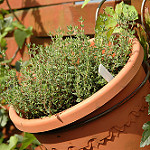Basil and Sage
Puree in water or oil and freeze in an ice cube tray. Transfer to ziploc bag once frozen.
Mint
Full or partially chopped leaves with water in ice cube tray.
Rosemary & Thyme
Cut twigs spead on cookie sheet and freeze. Once frozen transfer to freezer bag with air expressed.
Chives
Chopped and packed in freezer bag or canning jar.




